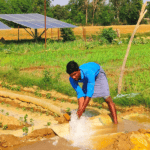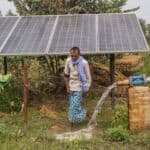The Next Big Thing for Energy Access in India? Service-Based Models for Productive-Use Appliances in Agriculture
The agriculture sector is a major source of livelihood in India, providing income to more than half of the total workforce. However, it lacks the reliable energy sources it needs to act as a motor for poverty alleviation.
Approximately 86% of India’s total farmer population is comprised of small and marginal farmers who own less than 2 hectares of land. Irrigation accounts for up to 30% of their total expenses, and is done mainly through electric or diesel-based pumps. With their small landholdings and limited incomes, the majority of farmers cannot invest in cost-effective technologies such as solar pumps. This is despite capital subsidy programs such as the government’s KUSUM scheme: Though designed for small and marginal farmers, it has benefited mainly those with larger landholdings. Small farmers are thus limited to growing rain-fed crops, or irrigating sparsely using motor pumps.
A dearth of reliable, affordable energy sources also holds back farmers who grow horticultural crops (fruits, vegetables, herbs and flowers). They are forced to sell their produce within a short post-harvest timespan due to the lack of cold-chain infrastructure to bring this perishable produce to market. This has led to nearly one-third of global food production being lost every year. Investment in the cold chain, specifically in pre-cooling and transport refrigeration equipment, could reduce India’s perishable food loss by 76% and CO2e emissions by 16%.
Irrigation and cold chain are just two productive uses of energy that have the potential to boost farmer livelihoods and help solve the present agrarian crisis, brought about by changing weather patterns and high variability in crop prices. They are also among the many agriculture-focused applications and appliances that can be powered by clean energy.
New markets in renewable energy
The global off-grid solar sector has grown exponentially over the last decade. With over 100 companies providing distributed energy solutions such as solar lamps and solar home systems (SHS), this market has matured significantly and has attracted investments over $1 billion. Over 108 million people are currently living with improved household energy access from off-grid solar products, which are providing lighting, phone charging and radio – and sometimes even powering TVs.
The industry has been driven by direct sales or leasing of small photovoltaic (PV) appliances (<250 Watt peak), whereby end-users end up owning the appliances after making small payments for 1-2 years. This has been enabled by the disruptive pay-as-you-go (PAYG) business model. PAYG has emerged as an effective, commercially-viable solution to provide decentralised energy access to rural and remote communities in developing nations. It is expected to reach over 10 million customers by 2020.
But the market is now shifting towards larger income-generating appliances used in small businesses and farms. This represents a $50 billion market in India alone. It spans various applications such as irrigation, cold storage, agro-processing, welding, poultry incubation, tailoring and many more. PV systems powering productive appliances are typically larger (around 500 – 5000 Watt peak), and so their upfront cost is significantly higher than for solar lamps or SHS. With target consumers dispersed in rural areas and having limited investment capability, the direct purchase of these capital-intensive appliances is cost-prohibitive. Therefore, alternate delivery models are needed.
The rise of service-based delivery models
Service-based models can be applied across multiple segments in the agriculture value chain to bring access to solar energy services to the most energy-deprived and low-income consumers, including small and marginal farmers. These service-based models allow consumers to access energy (or other commodities like water, storage space, etc.) derived from an appliance/product on a pay-per-use basis, making it financially accessible for those who do not have the ability or willingness to purchase the product itself.
The use of service-based models in the energy sector is not new in India. Many energy utilities have installed mini-grids providing electricity services to households and small businesses. What is new is the use of service-based models for productive energy applications. Irrigation and cold storage are two sectors that are ripe for transition to solar energy, driven by these models.
Oorja, where I work as a project analyst, has piloted a community-based, pay-as-you-go solar irrigation service, called Oonnati, for small and marginal farmers. As part of this service, Oorja installs, operates and maintains solar pumping systems for the community. The use of the PAYG model helps make this solar pumping affordable to smallholder farmers by avoiding the upfront costs of purchasing their own pumps: Instead, farmers pay for irrigation services in cash to the local pump operator. This provides farmers with affordable and reliable year-round access to water, and allows them to improve crop yields, grow high-value crops, and increase their income from farming.
This approach has shown its potential. But as organisations like ours look to scale these sorts of models, there is a growing need for automation and digitalisation – for instance, to facilitate payments and monitoring/maintenance of the pumping equipment. This need extends across the energy access sector, and it points toward a number of solutions and challenges.
The three dimensions to scale
As the energy access space develops, it needs to focus on becoming 3-dimensional. The 3Ds – decentralisation, decarbonisation and digitalisation – are interlinked trends that can address the energy challenges of developing economies.
The decentralisation and decarbonisation of the energy supply is already well underway in India, as seen in the growth of off-grid energy sources in both urban and rural areas. Urban India also has fast-growing rooftop and utility solar markets, and there is an active PV-driven rural electrification sector.
Digitalisation is the next frontier – and it’s more than just a means of collecting payments. Energy enterprises around the world have begun to realise the importance of combining solar power, internet of things connectivity and digital payments to successfully reach a wider population. For instance, embedding smart metering and digital payment systems will allow enterprises to remotely monitor system performance, detect faults, ensure better data collection on customers and impact metrics, and facilitate efficient operation and maintenance. It can also ensure that revenue realisation takes place in accordance with the actual usage of the system.
However, the payments element of this digitalisation process is still a major hurdle in India, which has a cash-centric economy. Several factors have impeded the spread of digital-based payments, including customers’ lack of awareness and financial illiteracy, the inconsistent reliability and quality of the power supply, and poor internet connectivity. Nevertheless, many analysts have a positive outlook on the country’s ability to resolve these issues, due to growing digital payment infrastructure and consumer awareness.
As India’s energy industry continues its evolution, rural enterprises like Oorja are committed to staying ahead of the game in implementing digitally-enabled service-based delivery models. We view these models as essential to making our energy services more inclusive, and to providing energy access to economically under-developed sections of society.
Lanvin Concessao is a project analyst at Oorja Development Solutions.
Photo provided by author.
- Categories
- Agriculture, Energy



